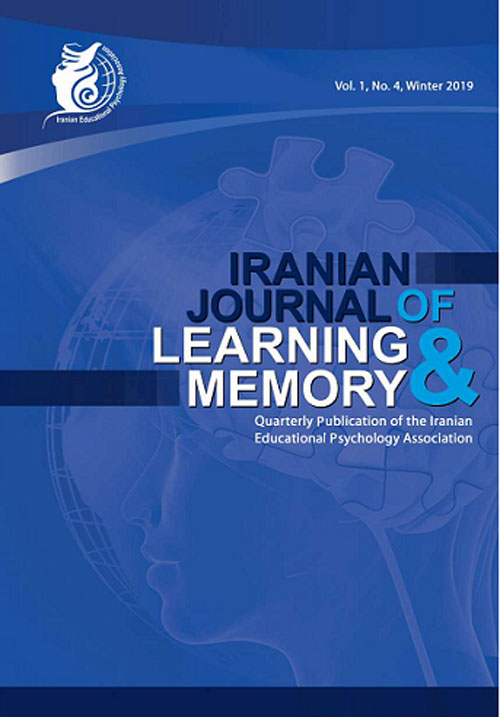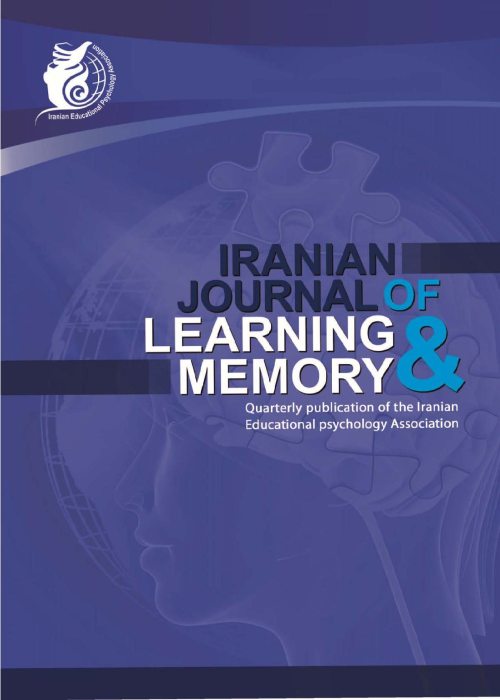فهرست مطالب

Iranian Journal of Learning and Memory
Volume:2 Issue: 5, Spring 2019
- تاریخ انتشار: 1398/02/11
- تعداد عناوین: 7
-
-
Pages 7-17This study investigated the predictive role of HEXACO personality traits (honesty-humility, emotionality, extraversion, agreeableness, conscientiousness, and openness to experience) in the speaking performance of Iranian EFL learners, and the role of gender in the relationship between HEXACO personality traits and EFL learners’ speaking ability. To this end, 250 learners (125 male and 125 female learners) were selected using a random cluster sampling method and were asked to complete the HEXACO personality traits questionnaire. The speaking ability of all the learners was checked via a scored interview. The speaking ability of the learners were evaluated by three interviewers (the researcher and two raters) based on the IELTS speaking bands. Fisher's Z and multiple regressions were used to analyze the data. The results indicated that extraversion, conscientiousness, and altruism could predict 90.3 percent of variance in the speaking ability of the participants. The findings also showed that the gender of the language learners did not have a predicting role in the relationship between personality traits of the language learners and their speaking ability.Keywords: HEXACO, personality traits, Speaking ability, Iranian EFL learners
-
Pages 19-26This study aimed at determining the effect of forehead cortex electric current stimulation on inhibitory control and working memory in people with attention deficit & hyperactivity disorder (ADHD), using TDCS device . The method used was quasi-experimental research with pretest-posttest control group design. participants were, 24 children with attention deficit and hyperactivity disorder, aged 7-11 who referred to Baqiyatallah Hospital in 1397. Children were randomly divided into experimental (n = 12) and control (n = 12) groups. The experimental group was intervened in 10 sessions, 3 times a week, and each session was 20 minutes. Assessments were performed in 3 steps, a day before the intervention, and a day after the intervention ended, and finally at the follow-up phase, two months after the intervention was accomplished. Go/no Go and N-back tests were used to evaluate inhibitory control & working memory, respectively. A repeated measurement method was applied to analyze the data. Findings revealed that brain electric stimulation program improves working memory and inhibitory control in children with attention deficit hyperactivity disorder. Therefore, brain electric stimulation program can be used to enhance the working memory and inhibitory control of children with attention deficit hyperactivity disorder.Keywords: forehead cortex_inhibitory control_working memory_attention deficit & hyperactivity disorder_Brain electrical stimulation
-
Pages 27-35The purpose of the present study was to examine the effect of observational Expert and beginner model on learning basketball free throw skill in those with different levels of imagination capability. For this purpose, 30 students with high imagination capability and 30 students with low imagination capability were selected among volunteered students and divided into 6 groups. The free throw accuracy and model were measured with 10 throws at the pre and post-test stages. At the exercise stage, the participants also performed 240 throws based on the specific protocol of the group. The experimental groups watched the video of the Expert or beginner model at the beginning of each exercise block. The control group did not watch any kind of video. The results of multivariate covariance analysis showed that the accuracy and the model of throws in different groups were significantly different. So that those with high imagination capability benefit more from observational learning and learned better than those with low imagination capability. Also, those with high imagination capability significantly benefit from Expert model observation. The results of this research show that in addition to the characteristics of the observed model, which can have a great impact on observational learning, the observers’ characteristics are also very influential in this. One of these effective characteristics was the individual's imagination ability, so that people with lower abilities were more likely to encounter problems with the use of observational learning. Therefore, developing of individual's imagination ability is necessary for this type of learning.Keywords: expert model, beginner model, imagination learning, imagination capability
-
Pages 37-45Learning vocabulary has always been a major concern for language learners. The current research was implemented to find out the kinds of Vocabulary Learning Strategies (popular, somehow popular, and unpopular) in Schmitt’s new taxonomy (DET, SOC, COG, MEM, MET) used by English-major students. Fifty advanced English-major students at Shahid Bahonar University of Kerman participated in this study. To this purpose, Schmitt’s Vocabulary Learning Strategies Questionnaire (VLSQ) and the last level of his Vocabulary Levels Test (VLT) were used as the instruments. It was found that MEM was the most frequently used category and SOC the least frequently used one. Furthermore, COG, DET, and MET were the second, third and fourth categories respectively. The results of the study can be used by various people involved in language education including materials developers, language teachers, administrators, and other stakeholders may make use of the findings, and at the end of the discussion section, some ways regarding how the mentioned groups can use the findings are provided.Keywords: Vocabulary Learning Strategies, Vocabulary size, Vocabulary Levels Test
-
Pages 47-53This study has examined the possible relationship between Iranian female intermediate EFL learners' personality traits and their vocabulary learning strategies. The participants in this study were 90 female intermediate English language learners. To make sure of their homogeneity, all the participants sat for the Oxford Solution Placement Test. Vocabulary Learning Strategies and Eysenck Personality questionnaires were administered to the participants. Subsequently, the data were subjected to statistical analyses. The results showed that there was not any statistically significant relationship between Iranian intermediate EFL learners’ personality type and their use of vocabulary learning strategy. However, , it appeared that introverts tended to have higher use of memory, cognitive, and metacognitive strategies, while extroverts achieved higher mean scores on determination and social strategies. Furthermore, according to the findings of phi and crammers’ v, the highest degree of relationship was reported for the correlation between social strategy and personality types. In contrast, the lowest amount of correlation was found between metacognitive strategy and personality types.Keywords: personality, language learning strategies, Vocabulary Learning Strategies
-
Pages 55-65The present study intended to examine the relationship between working memory (WM) and writing performance of a group of Iranian EFL learners and to explore whether learners with different working memory levels perform differently on the fluency, accuracy and complexity of texts produced or not. The necessary data were collected through an argumentative essay writing prompt and a computerized Persian version of reading span test as a measure of learners’ WM capacity. The correlation analysis revealed that there was a significant positive relationship between these two constructs. The results of Multivariate Analysis of Variance (MANOVA) indicated that there were significant differences between High, Mid and Low WM groups in terms of fluency and accuracy of texts produced, but not their complexity. These findings confirmed the importance of WM while working on cognitively challenging tasks such as writing which requires automation and effective management of cognitive resources while writing. On the whole, the present study confirmed the idea that learners with different learning characteristics orchestrate their mental resources in different ways to perform in different phases of writing and part of their difficulties or even capabilities in writing can be attributed to the efficiency with which they apply these resources while dealing with different writing systems (formulation, execution, or monitoring) or engaging in different writing processes (translating, planning, writing, reading, or editing).Keywords: accuracy, complexity, fluency, Working memory (WM), writing performance
-
Pages 67-77The present study aimed to compare the effects of physical, cognitive and combined rehabilitation on improving working memory and cognitive flexibility of the elderly living in the nursing home. This quasi-experimental study was carried out with a pretest-posttest design in four groups with the control group. The statistical population consisted of all elderly residents of a nursing home in Tehran. 48 people were selected randomly and divided into four groups (three experimental groups and one control group). For the experimental groups, intervention programs, including physical, cognitive, and combined rehabilitation, were conducted in three sessions of one hour each week for two months. The data were collected using a working memory capacity scale and a cognitive flexibility inventory (CFI). Data was analyzed using a one-way analysis of covariance (ANCOVA) and Bonferroni post hoc test using SPSS software version 22. The results showed that all three types of rehabilitation programs have a significant effect on improving the working memory and cognitive flexibility of the elderly (P <0.001). Also, the mean of groups in the pre-test and post-test stages showed that among the three programs, the combined rehabilitation program had more efficacy in improving the working memory and cognitive flexibility of the elderly and there was no difference between the two types of physical and cognitive rehabilitation programs (P> 0.001) According to the findings, combined rehabilitation programs can be effective in improving the working memory and cognitive flexibility due to the focus on both physical and cognitive aspects.Keywords: Cognitive rehabilitation, Elderly, flexibility, Memory, physical rehabilitation


